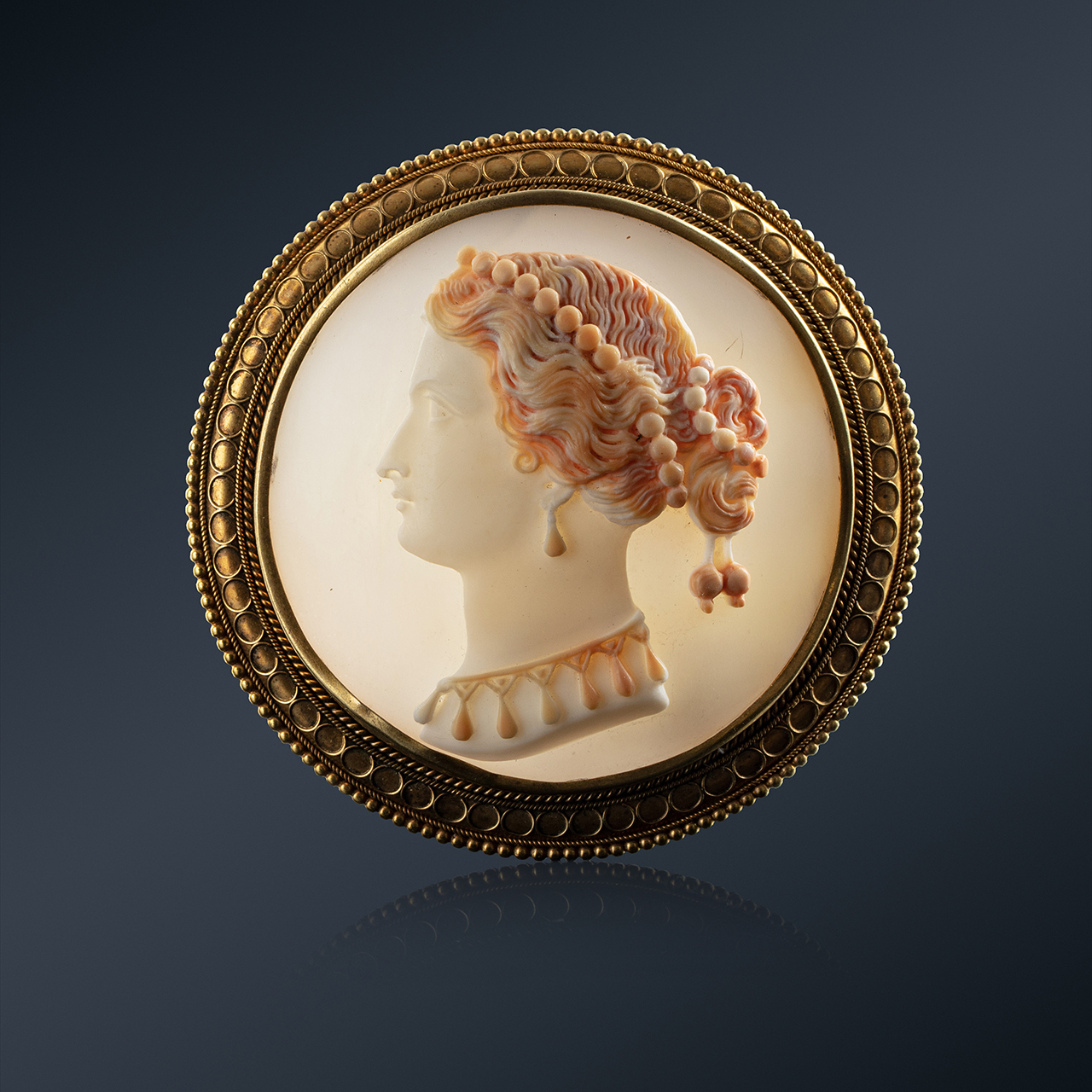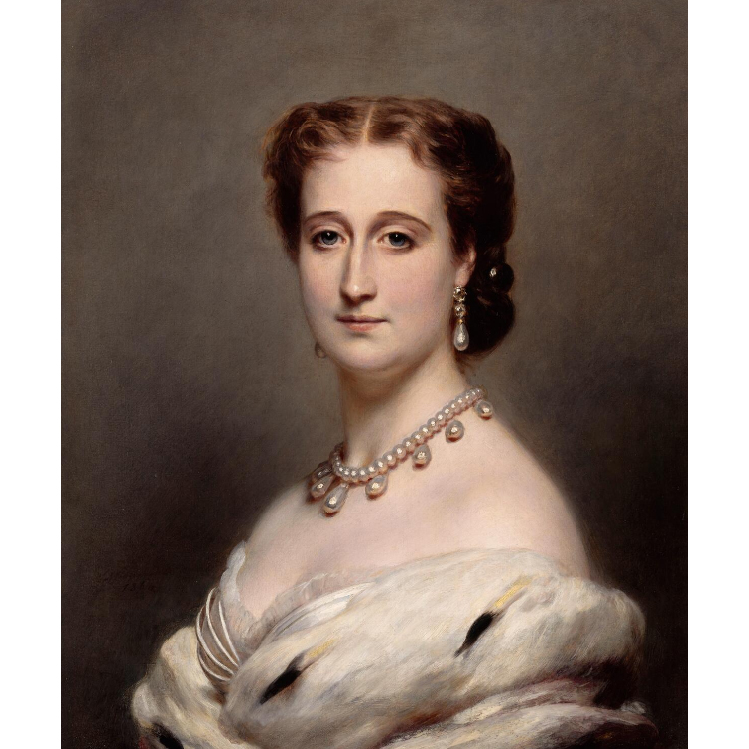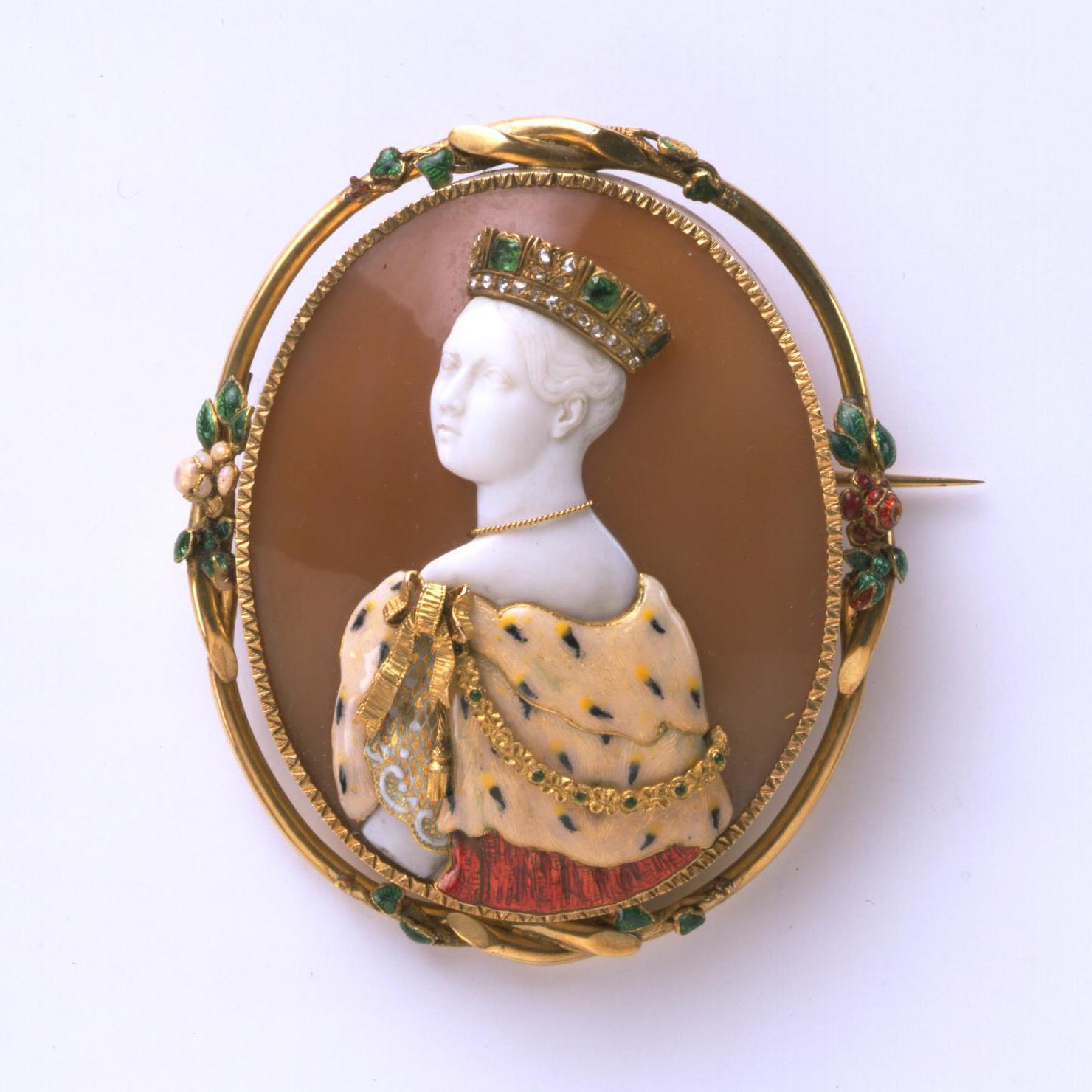Rare cameo engraved on shell called "camée coquille", with several layers, showing the left profile of the Empress inspired by the models of Nieuwerkerke and Peyre. The difference is that Eugenie wears here a pearl set including a one-row pearl necklace with nine pear pearls (that of the Duchess of Angoulême from the Crown Jewels. We will also note the resemblance to that of the Duchess of Sutherland which would have belonged to Queen Marie-Antoinette), two pear-shaped pearl earrings (personal purchase), and in the hair a long pearl necklace.
Circa 1853.
Mounted in a gold round brooch (18k) decorated with filigrees and beaded border in the neo-Greek or "neo-archaeological" taste.
Very good condition, the gold pin later added.
D. 6.2 cm (in total). Gross weight: 36.6 g.
- Salon of 1853 (Paris, Hôtel des Menus-Plaisirs), under n° 1399.
- Universal Exhibition of 1855 (Paris, Palais des Beaux-Arts, avenue Montaigne), under number 4450.
- Private collection, France.
Born in Paris, Paul-Victor Lebas began his career as a steel engraver before specializing in engraving on shell cameos, in contact with his masters the sculptor Caillouëtte and the Italian engraver Luigi Michelini. The latter, born in Rome in 1792 and died in Paris in 1857, antiquarian, mosaicist, engraver of shell cameos then on hard stones, exhibited at the Salon from 1855, where in particular Princess Mathilde was one of his clients, all like Count Colonna-Walewski. Lebas quickly surpassed the master since in 1851 he won a prize at the World's Fair in London for a cameo-commesso on a shell depicting Queen Victoria. Mounted as a brooch by Félix Dafrique, it is now kept at the Victoria & Albert Museum (inv. M.340-1977). He then exhibited at the Salon of 1852, a portrait of the Prince-President and two others of the Prince and Princess Lucien Murat. Then comes the Salon of 1853 where he exhibited a "camée coquille" of "the Empress" [Eugénie], of which it is specified: "after M. le comte de Nieuwerkerke and M. Peyre", leaving no doubt on the fact that it is indeed our model. For this work, he received the honorable mention of Third Class awarded by the Jury in the Sculpture category.
Apparently unsold or willing to keep it for the occasion, Lebas exhibited it two years later at the Paris Universal Exhibition of 1855 ; we do not know what became of it subsequently. The artist finally exhibited at the salons of 1865, 1866, 1868 and 1876, as "Prince Murat's engraver". He will receive a bronze medal at the Universal Exhibition of 1867 in Paris for cameos. He was a prestigious engraver since he had many students including August Wild (1814-1896) or François Reverchon (1829-?), But also his son, Paul-Charles Lebas, who also exhibited at the Salon in the same category (especially in 1876).
We know that Lebas painted several portraits of the Imperial Family, two of which in carnelian onyx are kept at the Metropolitan Museum in New-York:
- Emperor Napoleon III (inv. 40.20.14), laureate in profile right, circa 1867 (unsigned);
- The Prince Imperial (inv. 40.20.16), in left profile, circa 1865 (signed PL), whose portrait is close but does not copy the marble statue of Jean-Baptiste Carpeaux ordered by the Emperor in 1865 (Museum of the Louvre).
The National Museum of the Château de Compiègne has a marble bust (inv. MMPO.1289) and another in plaster (inv. C.52-D.1) made by Emilien de Nieuwerkerke (1811-1892) in 1852, where the The empress wears in her knotted hair a comb topped with pearl balls (or coral?) to be compared to our cameo. Under the direction of the same Count de Nieuwerkerke, the artist Jules Peyre (1811-1871) then executed in 1853 a model of a medallion with the profile of Eugenie in Sèvres biscuit, of which a beautiful copy in a blackened wooden frame is also found in Compiègne (inv. MMPO.1203). The influence of these two works produced in 1852 and 1853 on our copy being clear, Lebas must have made this cameo at the beginning of 1853 since he exhibited it at the Salon which began on May 15.
- Michel Duchamp, Glyptique, in Dictionary of the Second Empire, pp. 577-580.
- James David Draper, Cameo Appearances, The Metropolitan Museum of Art Bulletin, Spring 2008, Volume LXV, Number 4, New York, 2008, p. 49.
- The art of the jeweler, 1984, vol. II, n ° 904-905, p. 126.
- Bulletin of the French Numismatic Society, September 1992, article by Marcel Duchamp, p. 408.















